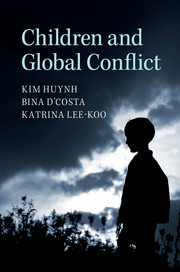Book contents
- Frontmatter
- Dedication
- Contents
- List of abbreviations
- Introduction: why children matter to global conflict
- 1 Children and armed conflict: mapping the terrain
- 2 Children and agency: caretakers, free-rangers and everyday life
- 3 Children and IR: creating spaces for children
- 4 The rights of the child: political history, practices and protection
- 5 Child soldiers: causes, solutions and cultures
- 6 Child forced migrants: bio-politics, autonomy and ambivalence
- 7 Children and peace building: propagating peace
- 8 Children and justice: past crimes, healing and the future
- 9 Who speaks for children? Advocacy, activism and resistance
- Conclusion
- Appendix
- Bibliography
- Index
7 - Children and peace building: propagating peace
Published online by Cambridge University Press: 05 May 2015
- Frontmatter
- Dedication
- Contents
- List of abbreviations
- Introduction: why children matter to global conflict
- 1 Children and armed conflict: mapping the terrain
- 2 Children and agency: caretakers, free-rangers and everyday life
- 3 Children and IR: creating spaces for children
- 4 The rights of the child: political history, practices and protection
- 5 Child soldiers: causes, solutions and cultures
- 6 Child forced migrants: bio-politics, autonomy and ambivalence
- 7 Children and peace building: propagating peace
- 8 Children and justice: past crimes, healing and the future
- 9 Who speaks for children? Advocacy, activism and resistance
- Conclusion
- Appendix
- Bibliography
- Index
Summary
Children and young people must play a key role in [the peace] process – not only because peace and security are basic ingredients for the full realization of children's rights, but because children are such a large proportion of the world's people.
Introduction
In October 2012, a Taliban assassin boarded a girls' school bus in Pakistan's Swat Valley. The gunman asked: ‘Which one of you is Malala?’ When the fifteen-year-old Malala Yousafzai was identified, she was shot in the face. This child had been targeted for assassination; she was a threat to the Taliban because she deigned to believe that her homeland might be better than it is, and because her activism had the power to influence others. Prior to the attack, Malala had been a long-time activist for girls' rights to education in Pakistan. When the Taliban issued an edict banning girls from school in her region, she and many of her classmates continued to attend. She had expressed her views as a blogger for BBC Urdu and became the subject of a New York Times documentary about her life in the Swat Valley.
Though a child, Malala understood conflict. She wrote on her blog in January 2009:
I had a terrible dream yesterday with military helicopters and the Taleban. I have had such dreams since the launch of the military operation in Swat. My mother made me breakfast and I went off to school. I was afraid going to school because the Taleban had issued an edict banning all girls from attending school.
As she wrote her blog, the Pakistani Army and the Taliban battled for control of her homeland and the Taliban in particular targeted civilian women and girls for gender-based violence. During the conflict, Malala had witnessed the public shooting of celebrated Pakistani female dancer Shabana, 3 and Malala herself was the victim of several threats of violence. This reinforced her already well-established and vocal commitment to defy the conflict that engulfed her community and seek a better future for herself and her schoolmates.
- Type
- Chapter
- Information
- Children and Global Conflict , pp. 185 - 211Publisher: Cambridge University PressPrint publication year: 2015
- 1
- Cited by



